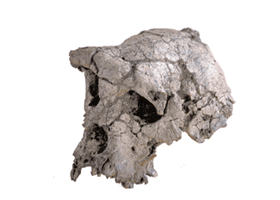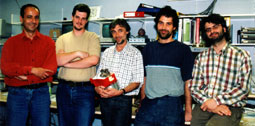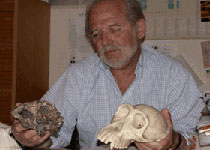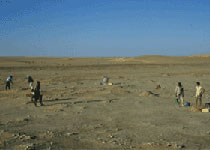- Home
- News
- General News
- Toumaï, our earliest...
Toumaï, our earliest relative, at the ESRF
23-05-2003
|
Close your eyes and let your imagination carry you in time to six or seven million years ago. It is probably a very hard job, isn't it? Believe it or not, a small but precious bit of that period has just been in the ESRF. The medical beamline has changed its speciality for some days to welcome Toumaï, our earliest relative ever found. |
|
Toumaï, properly known as Sahelanthropus tchadensis, is a seven million years-old skull that was found last year in Chad by a team of the University of Poitiers (France) and the international Mission Paleoanthropologique Franco-Tchadienne (MPFT), directed by Prof. Michel Brunet. A team of three palaeontologists have been working hard these last days at the ESRF using the imaging techniques at ID17 to get as much information about this skull as possible. |

Toumaï's skull. Copyright M.P.F.T. |
|
Toumaï - "hope of life", a local name for a child born perilously close to the start of the dry season- is believed to be the first hominid of human family. Although the size of its braincase is chimp-like, it has a short and straight face and small canine teeth used in its apical extreme, more like humans. |
 |
|
From left to right: Christian Nemoz (Medical beamline), Paul Tafforeau (Univ. Montpellier II, UMR CNRS 5554), Patrick Vignaud and Fabrice Lihoreau (Univ. Poitiers, UMR CNRS 6046 - Mission Paléanthropoligique Franco-Tchadienne), Alberto Bravin (Medical beamline). |
|
The Medical beamline is the chosen one to investigate on Toumaï, since it allows the research on its jaw, which measures nine centimetres. The data collected, once analysed, will provide information about how this hominid lived. For instance, the structure of the jaws or the email in the teeth can certainly explain the feeding habits of Toumaï. Fossils from the same date are being studied to get hints about its environment. "We want to get all the information about this hominid", says Patrick Vignaud, co-responsible of the MPFT and head of the team at the ESRF, "and the power of synchrotron light is essential for this aim". Their experiment at the ESRF is a very important point of a project that is to finish with a monograph about Toumaï and its environment published by Harvard University Press in around three years time. |
|
Michel Brunet comparing Toumaï with a chimpanzee. Copyright M.P.F.T. |
 |
 |
Excavation of hominid (TM266) by MPFT team. Copyright M.P.F.T. |
|
The oldest hominids found until last year were between five and six million years old and were in East Africa. That's why the find of Toumaï, published in Nature in July, stunned the world. Now it's time to reveal its secrets. |



